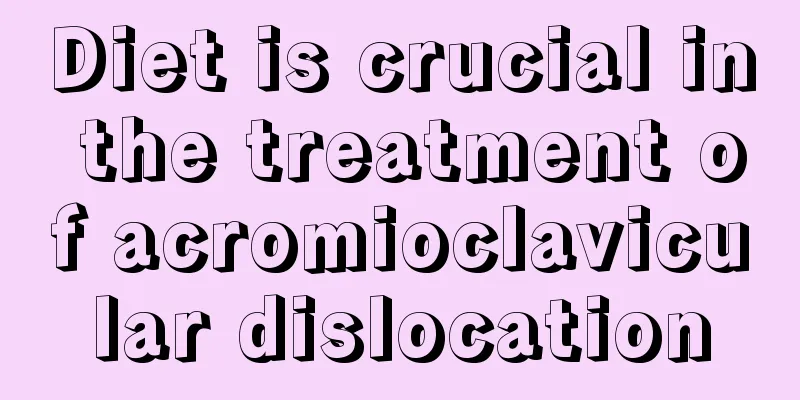Diet is crucial in the treatment of acromioclavicular dislocation

|
Conservative treatment and surgical treatment are currently the two common methods for treating acromioclavicular joint dislocation, and both have very good results. It should be noted that you should pay attention to your diet after the operation, improve your nutrition, eat more protein-rich foods, such as fish, eggs, soy products, etc., and increase calcium appropriately; drink more water, eat more vegetables and fruits, such as green vegetables, celery, bananas, etc. 1. Treatment 1. Conservative treatment For type I acromioclavicular dislocation, rest and sling with a triangular bandage for 1 to 2 weeks is sufficient; for type II dislocation, a sling can be used for fixation. The method is that the patient stands with both upper limbs raised high, and a plaster apron is put on first, with the upper edge at the same level as the nipple plane and the lower edge to slightly below the anterior superior iliac spine. An iron buckle is installed on the front and back of the apron. After the plaster is completely dry, a piece of thick felt is placed on the raised part of the outer end of the clavicle (do not place it on the acromion). Another 3-5 cm wide belt-type canvas belt is used to pass over the thick felt placed on the affected shoulder, and the two ends of the belt are tied to the iron buckles on the front and back of the plaster apron. Tighten it with appropriate force to compress and reposition the separated outer end of the clavicle. Take an X-ray to confirm reduction, wrap the injured limb with a triangular bandage, and fix it for 4 to 6 weeks. It can also be reduced under local anesthesia, with Kirschner wires cross-fixed from the distal end of the clavicle through the acromioclavicular joint and the acromion. The affected limb was suspended after the operation, the steel needle was removed after 6 weeks, and shoulder joint functional exercises were performed. 2. Surgical treatment For patients with total dislocation of the acromioclavicular joint, i.e. type III injury, the joint capsule, acromioclavicular ligament and coracoclavicular ligament have been ruptured, causing the acromioclavicular joint to completely lose stability. The above-mentioned external fixation effect is unsatisfactory. For patients under the age of 45, surgical repair should be performed. Commonly used surgical methods include open reduction and internal fixation of the acromioclavicular joint, reconstruction or fixation of the coracoclavicular ligament, resection of the lateral end of the clavicle, and muscle dynamic reconstruction. (1) Acromioclavicular joint open reduction and Kirschner wire fixation: This method is suitable for patients with type II dislocation. (2) Clavicle resection and coracoclavicular ligament transposition (3) Chronic acromioclavicular dislocation and acromioclavicular subluxation generally have no clinical symptoms and do not require surgical treatment. If there are symptoms such as pain in total dislocation, the following operations can be performed: ① Resection of the outer 1/3 of the clavicle, so that its appearance and function can be satisfactory; ② Transposition of the coracoacromial ligament to replace the coracoclavicular ligament: cut off the scapular end of the coracoacromial ligament, sew this end into the clavicular medullary cavity of the removed end, tighten and ligate; ③ Muscle dynamic transposition: After the acromioclavicular joint is open, reduced and fixed with Kirschner wires, the coracoid process is cut off from its base, and transplanted upward and inward to the clavicle together with the tendon on it, and fixed with screws. The tension of the muscles attached to the coracoid process is used to maintain the position of the clavicle after reduction. 2. Diet and Health Care 1. What foods are good for the body when the acromioclavicular joint is dislocated: Nutrition should be improved, and more protein-rich foods should be eaten, such as fish, eggs, soy products, etc., and calcium should be increased appropriately. Drink more water and eat more vegetables and fruits, such as green vegetables, celery, bananas, etc. 2. What foods should you avoid if you have acromioclavicular joint dislocation: Avoid irritating foods such as chili peppers, mustard, etc. Habits such as smoking and drinking should be given up. |
<<: Can fennel powder and rice vinegar cure body odor? These methods can help you
>>: Are the hazards of eyelash extensions really that serious?
Recommend
The most reasonable treatment plan for thyroid cancer
What is the most reasonable treatment for thyroid...
How to treat bone injuries
Many people often suffer physical injuries due to...
What diseases can heavy moisture cause and what are the hazards
If there is a lot of dampness in the body, the ca...
How to use a three-layer mask correctly?
Facial masks are very common things in our lives,...
Symptoms of prostate cancer cell spread in men
There are many things that can be done well, and ...
Common knowledge about fibroid care
Many people do not have good habits in life, whic...
Can rock sugar, lily and hawthorn remove tobacco poison?
Because people smoke frequently and the air quali...
Giving birth to a second child 8 years after cervical cancer surgery How to care after cervical cancer surgery
Ms. Wei (pseudonym) became a mother for the first...
Protruding chin
In physiognomy, it is often said that people with...
How to make delicious Hami melon
When eating Hami melon, if you only eat it fresh,...
Experts explain the specific symptoms of laryngeal cancer
Laryngeal cancer is a malignant tumor that seriou...
What are the advantages and disadvantages of dentures
Problems with any part of the body will cause us ...
How to treat lung cancer effectively? Three professional treatment methods for lung cancer in hospitals
Lung cancer, also known as bronchogenic carcinoma...
What is the length of the scar from hemisection of thyroid cancer
After hemisection of thyroid cancer, the length o...
Detailed introduction to common symptoms of early skin cancer
Nowadays, more and more people may suffer from sk...









